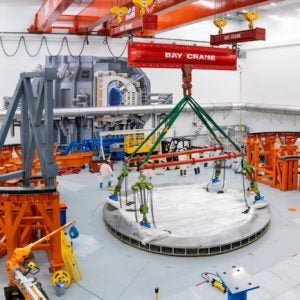
“From today, the project for the construction of a floating nuclear power plant in the city of Pevek, Chukotka Autonomous Okrug can be considered successfully completed. It has become the 11th industrially operated nuclear power plant in Russia and the northernmost in the world,” Rosenergoatom general director Andrei Petrov said.
The previous day, following the results of an inspection by the commission of the Far Eastern Department of regulator Rostekhnadzor, a compliance document was issued affirming that the FNPP was built in accordance with the requirements of the project documentation. In addition, a positive conclusion was obtained from Rosprirodnadzor, the Federal Service for Supervision of Natural Resources. These documents confirmed that the FNPP fully complies with all relevant standards and rules, including health and epidemiological, environmental, fire, building requirements and state standards.
The FNPP supplied the first electricity to the isolated network of the Chaun-Bilibino energy centre of Chukotka on 19 December 2019. Since inclusion in the network, the FNPP has already generated over 47.3GWh of electricity. Currently, it provides 20% of the needs of the Chaun-Bilibino energy centre. In future, once all four units of the ageing Bilibino nuclear plant are shut down, the FNPP will become the main source of energy supply for Chukotka.
Bilibino will be decommissioned in stages and the new energy supply scheme of Chukotka should fully operational by 2023. Bilibino comprised four unique 12MWe uranium-graphite pressure-tube EGP-6 reactors commissioned between 1974 and 1976. The decision to close them was approved in March 2016. Bilibino 1 was permanently shut down in January 2019 and Bilibino 2 has had its operating licence extended until 2025.
The FNPP comprises a dedicated system of coastal infrastructure to support the Akademik Lomonosov floating power unit, which is equipped with two KLT-40S reactors with an electric power of 35MW each. The power capacity of the FNPP is 70MW, the heat capacity is 50 Gcal/h.
With the two FNPP reactors, the total number of nuclear power reactors in commercial operation in Russia is now 38, with four more under construction.
The keel of Academik Lomonosov was laid in April 2007 at Sevmash in Severodvinsk, but in August 2008 Rosatom cancelled the contract and transferred it to the Baltic Shipyard in St Petersburg.
New keel-laying started in May 2009 and the 21,500t hull was launched at the end of June 2010.
The two reactors were installed in October 2013.
Academik Lomonosov left the Baltic Plant in April 2018 on the first leg of its journey to Murmansk where it was loaded with fuel and took on board its crew. The loading of fuel was completed in early October 2018.
In June 2019, Rostekhnadzor issued a 10-year licence to Rosenergoatom to operate the Akademik Lomonosov until 2029.
The Akademik Lomonosov is the lead project of a series of mobile transportable low power units to be sited in the Far North and the Far East. It will be a key infrastructural element in the Northern Sea Route development programme. The aim is to provide energy to remote industrial enterprises, port cities, as well as gas and oil platforms located in the open sea.
Rosenergoatom said the FNPP has been designed with a large margin of safety to counter external threats. Rosatom is already working on a second generation floating nuclear plant, an optimised floating power unit, which will be smaller and will be equipped with two 50MWe RITM-200M reactors.
Photo: Academik Lomonosov has entered commercial operation (Photo: Rosatom)






